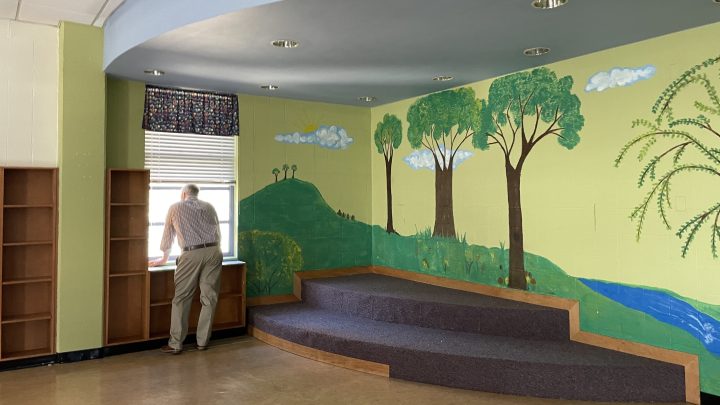
Church? Apartments? As youth population drops, developers reimagine schools
Church? Apartments? As youth population drops, developers reimagine schools

Before showing off the former Dr. Martin Luther King Jr. Elementary/Middle School in northwest Baltimore, Kelly Baccala lets a group of developers know they’ll be in for some exercise.
“The elevators are working. We are not able to use them. There are two keys involved that I do not have,” Baccala said.
How many elevators are there, one developer wanted to know.
“There’s just one. So when I said elevators, that was a lie,” Baccala said.
Baccala works for the city of Baltimore, which is selling this school. MLK is one in a series of schools Baltimore has closed over the last decade as it’s dealt with a fluctuating school-age population. An increasing number of communities around the country are facing this problem. Following the 2008 recession, people had fewer kids, which means, now, we need fewer schools. Affected districts have been closing schools they don’t need. Sometimes they hold on to the building, sometimes they demolish it, and sometimes they sell it to people with big dreams.
At the tour of MLK, those dreamers need their phone flashlights. The power’s off in the building, which has been closed since 2020. The kids who would have been pupils here now attend school more than a mile away. There are plenty of reminders of what this used to be: a globe on the floor in one classroom, empty shelves and small tables and chairs still present in the library. But where a reporter sees a former science lab, with kids’ handprints still on a mural at the back, real estate developer Nicole Earle sees a cozy one-bedroom apartment.
“It has the walls, the structure,” Earle said. “I mean, you still have to add closets and bathrooms. But as you can see, there’s some plumbing already in here.”
This is the first chance for many developers to see inside the school, which was built in 1973, just five years after its namesake’s death. Baccala herds developers down the dark interior staircase to the library and empty office (where, she lets us know, the intercoms no longer work). In the cafeteria, there’s a sign that reads “MLK Café,” along with a very funky smell.
“Something may have ended its days there,” said Bishop J. Charles Carrington Jr., a pastor (whose email address starts with “da bish”). He wants to make the school into a new headquarters for his church, and he’s positive even about that scent.
“It can be fixed,” Carrington said. “Bleach fixes everything.”
Baltimore is taking bids from potential buyers, who will have to buy more than just bleach. The city estimates the school needs at least $800,000 worth of work, no matter what it becomes. Carrington may offer $1.5 million for the school, which would go to the city’s capital budget.
“The focus is not so much making the funding, but getting that property no longer vacant and useful for you and I,” said Teresa Stephens, who works in neighborhood development for Baltimore.

MLK had only 244 students attending at the end, compared to the mid-’80s when enrollment was over 950.
“Nobody really knows how many schools are vacant at any given point. But there’s a lot,” said Alan Mallach, a senior fellow with the Center for Community Progress.
To understand what’s happening across the country, you have to go back to when about half of these schools were built, in the 1950s.
“After World War II, we really did have an explosion of children,” Mallach said.
It was the baby boom. Then, a few decades later, those boomers had kids of their own, which is what demographers call an echo. After that, U.S. population growth leveled off, and since 2008, it’s been dropping.
“The world of demographers said, ‘Well, it’s a short-term blip. When the economy picks up, it’ll go back up again.’ But it didn’t,” Mallach said.
So maybe it’s appropriate that one of the most successful reuses for schools is senior housing.
Emily Dowdall, with the nonprofit Reinvestment Fund, who has researched repurposing schools, said that lets developers blend financing sources like low-income and historical tax credits.
“Additionally, senior housing is unlikely to cause a fuss in a neighborhood,” Dowdall said. “There’s no late night parties.”

Other potential buyers are charter schools, startups looking for office space or people who just want the land.
But none of those choices are without controversy. Back in northwest Baltimore, 19-year-old Nya Garnett lives near the former MLK school and is disappointed it won’t be a school any longer.
“Normally, with historical figures, you name stuff after them. Now, you have something named after you. And it’s closed. It kind of seems like, what was it for?” Garnett said.
Now its use is changing, which can be difficult for a community to deal with. Because if public schools signal a city’s investment in the future, it can be hard to acknowledge that future doesn’t involve as many children.
There’s a lot happening in the world. Through it all, Marketplace is here for you.
You rely on Marketplace to break down the world’s events and tell you how it affects you in a fact-based, approachable way. We rely on your financial support to keep making that possible.
Your donation today powers the independent journalism that you rely on. For just $5/month, you can help sustain Marketplace so we can keep reporting on the things that matter to you.

















